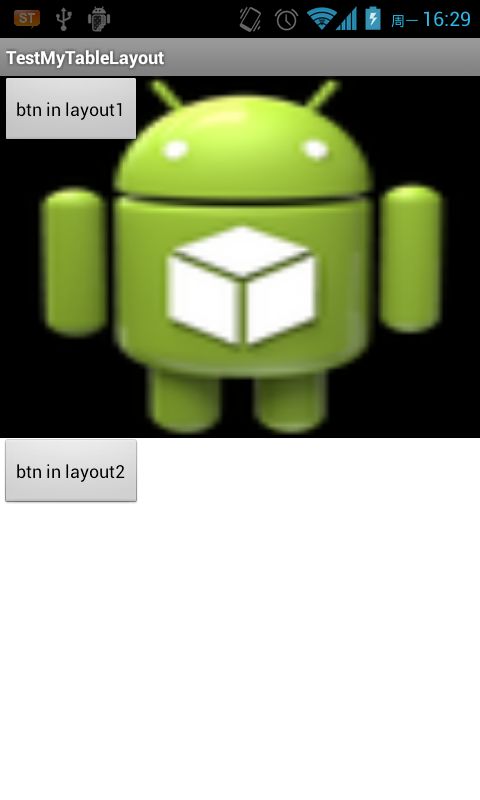Android中Scroller类的分析
做android也快两年了,连最基本的滚动都不熟悉,真是惭愧。。。遂网上找资料,很容易的在google前排找到此文章:
Android Scroller类的详细分析 http://blog.csdn.net/gemmem/article/details/7321910
很受启发,学习之后总结一下自己的心得。
文章中的内容这里就不再重复了。
如文章中所写,在弄明白滚动的原理之前,需要先明白computeScroll() 这个方法。
computeScroll()是View类的一个空函数,在父容器重画自己的孩子时,它会调用孩子的computScroll方法。所以这个computeScroll()函数正是我们大展身手的地方,在这个函数里我们可以去取得事先设置好的成员变量mScroller中的位置信息、速度信息等等,用这些参数来做我们想做的事情。
然后放下代码,先考虑几个问题:
1.如何触发滚动?
2.谁要滚动?或者说哪个View要滚动?
3.从哪滚到哪?滚多久?
4.怎么滚动?
脑海中有这几个问题之后,好吧,看一下代码,直接拷一下上述作者文章中的,自己格式化稍改了一下:
package cn.supersugar.tablelayout; import android.widget.LinearLayout; import android.widget.Scroller; import android.app.Activity; import android.content.Context; import android.graphics.Canvas; import android.os.Bundle; import android.util.Log; import android.view.View; import android.widget.Button; import android.view.View.OnClickListener; public class TestMyTableLayoutActivity extends Activity { private static final String TAG = "TestScrollerActivity"; LinearLayout lay1, lay2, lay0; private Scroller mScroller; @Override public void onCreate(Bundle savedInstanceState) { super.onCreate(savedInstanceState); mScroller = new Scroller(this); lay1 = new MyLinearLayout(this); lay2 = new MyLinearLayout(this); lay1.setBackgroundDrawable(getResources().getDrawable(R.drawable.ic_launcher)); lay2.setBackgroundColor(this.getResources().getColor( android.R.color.white)); lay0 = new ContentLinearLayout(this); lay0.setOrientation(LinearLayout.VERTICAL); LinearLayout.LayoutParams p0 = new LinearLayout.LayoutParams( LinearLayout.LayoutParams.FILL_PARENT, LinearLayout.LayoutParams.FILL_PARENT); this.setContentView(lay0, p0); LinearLayout.LayoutParams p1 = new LinearLayout.LayoutParams( LinearLayout.LayoutParams.FILL_PARENT, LinearLayout.LayoutParams.FILL_PARENT); p1.weight = 1; lay0.addView(lay1, p1); LinearLayout.LayoutParams p2 = new LinearLayout.LayoutParams( LinearLayout.LayoutParams.FILL_PARENT, LinearLayout.LayoutParams.FILL_PARENT); p2.weight = 1; lay0.addView(lay2, p2); MyButton btn1 = new MyButton(this); MyButton btn2 = new MyButton(this); btn1.setText("btn in layout1"); btn2.setText("btn in layout2"); btn1.setOnClickListener(new OnClickListener() { @Override public void onClick(View v) { mScroller.startScroll(0, 0, -30, -30, 500); //开始滚动,设置初始位置--》结束位置 & 持续时间 } }); btn2.setOnClickListener(new OnClickListener() { @Override public void onClick(View v) { mScroller.startScroll(20, 20, -50, -50, 500); } }); lay1.addView(btn1); lay2.addView(btn2); } class MyButton extends Button { public MyButton(Context ctx) { super(ctx); } @Override protected void onDraw(Canvas canvas) { super.onDraw(canvas); Log.d(TAG, this.toString() + " onDraw------"); } } class MyLinearLayout extends LinearLayout { public MyLinearLayout(Context ctx) { super(ctx); } @Override public void computeScroll() { Log.d(TAG, this.toString() + " computeScroll-----------"); if (mScroller.computeScrollOffset())//如果mScroller没有调用startScroll,这里将会返回false。 { //因为调用computeScroll函数的是MyLinearLayout实例, //所以调用scrollTo移动的将是该实例的孩子,也就是MyButton实例 scrollTo(mScroller.getCurrX(), 0); Log.d(TAG, "getCurrX = " + mScroller.getCurrX()); //继续让系统重绘 getChildAt(0).invalidate(); } } } class ContentLinearLayout extends LinearLayout { public ContentLinearLayout(Context ctx) { super(ctx); } @Override protected void dispatchDraw(Canvas canvas) { Log.d(TAG, "contentview dispatchDraw"); super.dispatchDraw(canvas); } @Override public void computeScroll() { } } }
上运行截图:
如上,一一分析这四个问题:
1.按钮的点击事件触发了滚动
3.mScroller.startScroll()方法定义了滚动的路径和时间
好,1没问题,3也没问题,问题是2和4。
先看问题2:谁要滚动?
我在看完代码的时候我不知道谁会滚动- -...我猜是layout1,但是注释里写的是bt1!
然后我把代码跑到手机上看,果然是bt1...
可以看到,点击bt1的时候,bt1向右按照原计划向右滚动了。可是computeScroll()方法不是在bt1的父view中重写的吗?
据作者所写:
//因为调用computeScroll函数的是MyLinearLayout实例,
//所以调用scrollTo移动的将是该实例的孩子,也就是MyButton
scrollTo(mScroller.getCurrX(), 0);
然后查看scrollTo的api:
Set the scrolled position of your view. This will cause a call to onScrollChanged(int, int, int, int) and the view will be invalidated.
依然不很理解,所以只好这么认为吧:谁调用了scrollTo,谁的孩子就滚动。
换句话说:谁想滚找他爹!!!
然后,在layout1中又添加了一个bt3,点击bt1的时候,果然bt3跟bt1一起滚了...那么2就有了答案。
再看问题4:怎么滚动?
其实当mScroller.startScroll(0, 0, -30, -30, 500)这局代码执行之后,由于最后一个参数传入的是执行时间,在这个时间范围内,也就是滚动没有执行完的时候,mScroller.computeScrollOffset()返回的都是true!
在这个过程中,mScroller.getCurrX()的值却是一直在变化的,变化的范围你懂的。
然后呢?界面怎么动呢?当然是不断的重绘了!
怎么不断重绘?getChildAt(0).invalidate()就是这句,然后系统会一直重复的执行computeScroll(),直到设定的时间结束,view也会滚动指定的位置,mScroller.computeScrollOffset()返回值变为false,这样就完成了整个滚动过程。
到这儿的时候差不多已经吸收了原作者要给的知识了,再看一个额外的:
每个view都有computeScroll()方法,那么在mScroller.startScroll()发起滚动的时候,ContentLinearLayout 能不能“听到”这个命令?
应该是能的!把MyLinearLayout 中的computeScroll()方法copy至ContentLinearLayout 中,方法同样会执行,那么滚动的就是layout1+layout2了!
试了试确实是这样的,再次验证了谁要滚找他爹!
那么问题4也有了答案。
如果这4个问题都有答案的话,那么相信对scroller也有一定的理解了吧,剩下的就是与其他知识结合再深入研究了。
